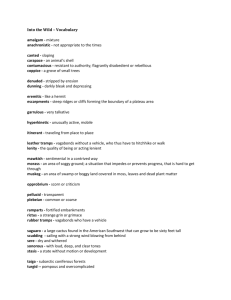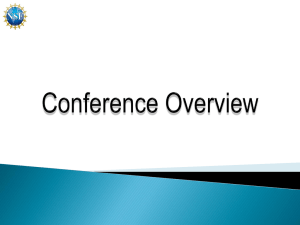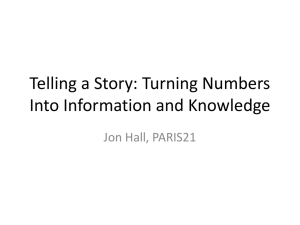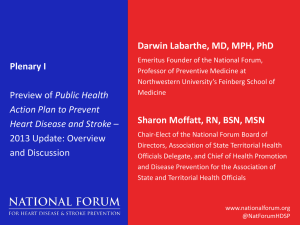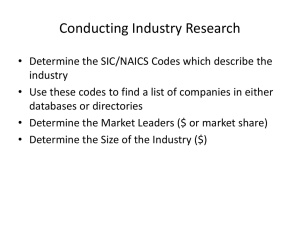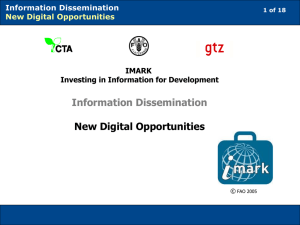PPT - NetLab@SYSU
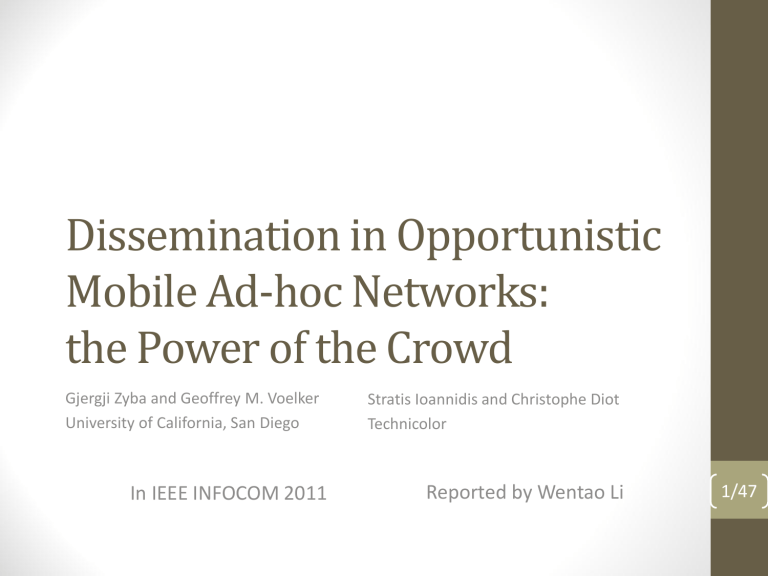
Dissemination in Opportunistic
Mobile Ad-hoc Networks: the Power of the Crowd
Gjergji Zyba and Geoffrey M. Voelker
University of California, San Diego
Stratis Ioannidis and Christophe Diot
Technicolor
In IEEE INFOCOM 2011 Reported by Wentao Li 1/47
Abstract
• Opportunistic mobile ad-hoc networks
• The relationship between properties of human interactions and information dissemination
• Use three different experimental traces to study
• User classification: Socials and Vagabonds
• the effectiveness of dissemination predominantly depends on the number of users rather than their social behavior
2/47
Outline
•
Introduction
• Related work
• Data sets
• Socals and Vagabonds
• Contact properties
• Data dissemination
• Analysis
• Conclusions
3/47
Introduction
• Mobile ad-hoc communication and social networking applications supported entirely through opportunistic contacts in the physical world
• Communication in opportunistic mobile ad-hoc networks is challenging
• the volatility of contacts
• communication technologies
• resource limitat
• Communication is also strongly impacted by human mobility, which is driven by user social behavior
4/47
Introduction
• Progress in understanding opportunistic mobile ad-hoc networks is mainly limited
• difficulty to collect complete traces
• difficulty to model large systems with realistic assumptions
(absence of large experimental data sets)
• Difficulty in the experimental
• collect traces that contain enough information about each device (mobility, social profile, contact opportunities, duration of contacts, communication technology)
• not biased by constraints due to experimental conditions
5/47
Introduction
• Data collection
• a need to collect and consider data that encompasses the behavior of all devices in a population— not just experimental devices
• process traces by subdividing each trace based on a specific social or professional geographical area of interest
• define two classes of populations with different presence characteristics, namely Socials and Vagabonds
6/47
Introduction
• Contribution
• Study data dissemination spanning a large range of Social and Vagabond compositions
• Observe that the efficiency of content propagation is not only a consequence of the devices’ social status, but also a consequence of the number and density of devices
• Study both experimentally and analytically the “tipping”
point beyond which the population size becomes more significant than the social status
7/47
Outline
• Introduction
•
Related work
• Data sets
• Socals and Vagabonds
• Contact properties
• Data dissemination
• Analysis
• Conclusions
8/47
Related work
• Social-based routing protocols
• Use social-based metrics to make opportunistic forwarding decisions
• SimBet, Bubble Rap and PeopleRank
• Our work exploring the role and potential of non-social,
vagabond devices for communication and data dissemination
• Social networking concepts have been used in mobile opportunistic applications
• Our analysis focuses mostly on epidemic message dissemination
9/47
Outline
• Introduction
• Related work
•
Data sets
• Socals and Vagabonds
• Contact properties
• Data dissemination
• Analysis
• Conclusions
10/47
Data sets
• Three data sets - represent distinct and considerably different mobile environments
• Dartmouth
• San Francisco (SF)
• Second Life (SL)
• We further subdivide Dartmouth and SF into smaller geographical areas which have different social behavior characteristics
11/47
Dartmouth
• Data set comprises logs of association and disassociation events between wireless devices and access points at
Dartmouth College
• The logs span 60 days and include events from 4920 devices(4248 avaiable)
• In contact - when associated with the same access point
• Subdivide areas
• Engineering (300m × 200m)
• Medical (300m × 300m)
• Dining (150m × 150m) 12/47
San Francisco
• Data set consists of GPS coordinates of 483 cabs operating in the San Francisco area
• collected over a period of three consecutive weeks
• In contact - whenever their distance is less than 100 meters(realistic range for WiFi transmissions)
• Subdivide areas
• Sunset (2km × 6km)
• Airport (0.7km
× 1km)
• Downtown (2km × 2km)
13/47
Second Life
• Data set captures avatar mobility in the Second Life (SL) virtual world
• consists of the virtual coordinates of all 3126(2713 avaiable) avatars that visit a virtual region during 10 days
• In contact - when they are within a vicinity of 10 meters
(a reasonable range for Bluetooth)
• We do not define sub-areas in this data set as the virtual region is small (300m × 300m)
14/47
Data sets
15/47
Outline
• Introduction
• Related work
• Data sets
•
Socals and Vagabonds
• Contact properties
• Data dissemination
• Analysis
• Conclusions
16/47
Socals and Vagabonds
• We first classify users according to their social mobility
Behavior
• Socials
• devices that appear regularly, predictably in a given area
• Vagabonds
• devices that visit an area rarely and unpredictably
17/47
Identifying Vagabonds and Socials
• Methods based on
• how long they stay in a given area
• the regularity of their appearance in an area
• A five-day consecutive weekday period
• Identifying methods
1.
Least Total Appearance
2.
Fourier
3.
Bin
18/47
Least Total Appearance
• Total appearance
• the total time spent by each device within an area during the five-day period
19/47
Least Total Appearance
• 75% of the population appears less than 20% of the time
• Few devices stay within an area for longer periods –
Social
• Inflection points
• significant changes in curvature
• linear regression in the range [0, t]
• error in approximation when the correlation r is such that r 2 < 0.9
Inflection point: above is social
20/47
Fourier
• detects periodicity
• relies upon the Fourier transformation and the autocorrelation of the appearance of a user in an area
Dartmouth Medical
Threshold: above is social
21/47
Bin
• is motivated by the observation that people’s mobility patterns exhibit a diurnal behavior
• detects if a user appears every day in an area, and
consistently during the same time period
• Bins
• divide our measurement period into bins of equal size b
• Binary stirng
• represent the appearance of each device over time
• flag a time bin with “1” if the device appears in the area during the period corresponding to this bin, “0” otherwise 22/47
Bin
• Periodic
• appears every day, at a specific period of the day
• a device whose corresponding string has a “1” every 24/b bits is periodic
• For flexibility, we identify a device as periodic even when an exact bin is not flagged but a neighboring bin is
• Periodic – Social, otherwise Vagabond
• Bin sizes of 3 hours
• around this time granularity the results are not very sensitive to the bin size
23/47
Classifying Vagabonds and Socials
under all methods, in most of the areas Vagabonds represent the majority of the population
24/47
Classifying Vagabonds and Socials
overlaps are similar for LTA and Bin yet surprisingly different for Fourier. For balance, we choose Bin.
25/47
Outline
• Introduction
• Related work
• Data sets
• Socals and Vagabonds
•
Contact properties
• Data dissemination
• Analysis
• Conclusions
26/47
Contact properties
• Contact characteristics are key in the effectiveness of opportunistic ad-hoc communication
• Examine three different contact metrics
• Contact rate
• Inter-contact time
• Contact duration
• Study these metrics for four different contact scenarios
• Social-meets-Socials (SS)
• Vagabond-meets-Socials (VS)
• Social-meets-Vagabonds (SV)
• Vagabond-meets-Vagabonds (VV) 27/47
Contact rate
• Contact rate
• For each device, we compute the number of contacts per hour with other devices in the social or vagabond group
• Normalize - to remove the bias introduced by the size of the target population
Socials dominate
Balance
Vagabonds dominate
28/47
Contact rate
• the SS contact rate is an order of magnitude higher than the VV contact rate
• the VS and SV contact rates somewhere in between
• VS and VV - long tails, SS and SV - short tails
29/47
Inter-contact time
• Inter-contact time
• The time interval of a device that starts with the end of a contact and ends with the beginning of the next contact
• It characterizes the periods during which a device cannot forward any content to other devices
30/47
Inter-contact time
• two different parts in each curve
• the main body (roughly below 12 hours)
• the tail of the distribution (above 12 hours)
• it characterizes the mobility patterns that are specific to each area
• longer tails when the device met is a Vagabond, which explains later why vagabonds are not individually as effective at content
• dissemination
31/47
Contact duration
• The amount of data that can be transmitted between two devices depends both on contact durations and on the communication technology
• It is difficult to interpret and does not characterize the performance
• Mostly a characteristic of the mobility in the area
• We find that Socials and Vagabonds experience comparable contact characteristics and their distributions are very similar
32/47
Outline
• Introduction
• Related work
• Data sets
• Socals and Vagabonds
• Contact properties
•
Data dissemination
• Analysis
• Conclusions
33/47
Data dissemination
• Trace driven simulations
• replay each trace multiple times using only Socials, only
Vagabonds, or any device to propagate messages
• Observation
• in areas in which Vagabonds outnumber Socials significantly, dissemination using Vagabonds outperforms dissemination using Socials, despite the lower contact rate experienced by Vagabonds
• Predict
• population is going to be more effective at propagating information
34/47
Methodology
• Flooding
• Nomorize - Repeat the simulation by uniformly sampling many start times between the beginning of the selected week (Sunday midnight) and the middle of that week
(Wednesday noon)
• Simulations last 2.5 days to ensure they all complete within the week-long trace
• Assume that message transfers are instantaneous
• Metric – contamination
• the number of devices that receive a given message as a function of time
35/47
Evaluation
• Socials outperformVagabonds in areas where they are the majority
(SF Downtown) or of comparable population size (Dartmouth
Engineering)
• in areas where Vagabonds largely dominate, they exhibit better contamination characteristics than Socials (Second Life)
• large populations of Vagabonds can achieve the same contamination performance as Socials
36/47
Evaluation
• We decrease the number of Socials(or Vagabonds) when the social(Vagabonds) group performs better in an area, until we observe a similar contamination ratio for dissemination
• To have comparable contamination ratios, Vagabonds need to number two to six times more than Socials
37/47
Outline
• Introduction
• Related work
• Data sets
• Socals and Vagabonds
• Contact properties
• Data dissemination
•
Analysis
• Conclusions
38/47
Analysis
• Goal
• formally characterize the relationship between the
population size and the social behavior of users under which such phenomena occur
• Approach
• a so-called “mean field” limit applied to epidemic dissemination
39/47
Model Description
• Notations
40/47
Model Description
• Vagabonds and Socials
• N mobile users visiting an area A
• Partitioned into the two classes: Vagabonds( N v
) and
Socials( N s
)
• Time is slotted, and at each timeslot a Vagabond(Socials) enters A with probability ρ v
( ρ s
), independently - occupancy rate
• Assume: ρ v
≪ ρ s
• ρ v
N v
( ρ s
N s
) - the density of each class
41/47
Model Description
• Contacts between users and data dissemination
• At each timeslot, we select two users uniformly at random among all (unordered) pairs of the N users in the system
• If both of these users are within the area A then a contact takes place between them
• denote by λ vv
, λ vs
, λ sv
, and λ ss the probabilities that transmissions succeed across and within classes
• Main Result(Theorem 1)
• For large enough N, the epidemic dissemination using
Vagabonds eventually dominates dissemination using
Socials if and only if N v
ρ v
2 > N s
ρ s
2
42/47
Proof of Theorem 1
• A fluid limit
• Fractions of the total population: r v
= N v
/N, r s
• Number of infected(susceptible): I v
, I s
(S v
, S s
)
= N s
/N
• Fractions of infected(susceptible): i v
S v
/N, s s
= S s
/N )
= I v
/N, i s
= I s
/N (s v
• Number of infected users in each class, is a stochastic
= process:
• i(t) can be approximated with arbitrary accuracy through the solution of the following ordinary differential equation
(ODE)
43/47
Proof of Theorem 1
44/47
Numerical Validation
45/47
Outline
• Introduction
• Related work
• Data sets
• Socals and Vagabonds
• Contact properties
• Data dissemination
• Analysis
•
Conclusions
46/47
Conclusions
• We separating users into two behavioral classes
• Although Socials form an active population subset, most areas are dominated by Vagabonds in terms of population size
• Vagabonds, often excluded as unimportant, can often play a central role in opportunistic networks
• This work is just a first step in studying the impact of social behavior of users on information dissemination
• Interesting directions
• the characteristics of inter-area message propagation
• the dynamics of user social behavior (e.g., Vagabonds becoming
Socials in other areas)
• the interactions between Vagabonds and Socials in supporting information dissemination
47/47
